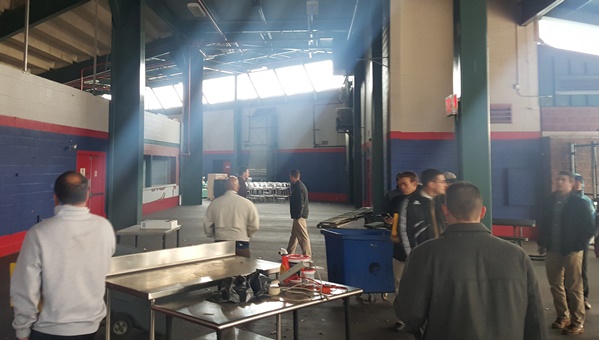The New Britain Rock Cats minor league baseball franchise had been a staple of the community in New Britain, Connecticut, for more than 30 years — until they abruptly left town in late 2015 for a newer stadium in nearby Hartford.
Fortunately for the city, local fans had established such a strong culture that New Britain Stadium wouldn’t remain without a tenant for long. As the Rock Cats left, baseball’s Atlantic League announced that a new franchise, the Bees, would arrive in time for the 2016 season.
Preparing the downtown ballpark for a new franchise, though, meant substantial offseason renovations were needed, and fast — all in the midst of a brutal New England winter. Project specifications included renovations to the concourse, team locker rooms, bathrooms, suites, and eventually the outfield fence.
“The stadium was in pretty beat-up shape,” said Vaughn Butler, owner and president of regional coatings contractor Scholar Painting, chosen to perform the renovations. “It needed a paint job and needed to be cleaned up. We basically had to scrub the old team out of existence.”
Lineup Heats Up
Because the Rock Cats didn’t move out until after the 2015 season, the transition of the branding and color scheme — from largely red for the Rock Cats, to yellow, black, and white for the Bees — couldn’t begin until the offseason. The job was put out to bid in early January, and after securing the contract, the Scholar Painting team knew it had to start work in early February in order to finish by the Bees’ scheduled season opener in mid-April.
The biggest problem, of course, was the weather. The outdoor stadium was completely without heat, even in the suites and locker rooms, and temperatures in the teens (-7 to -10 °C) were not conducive to the climate needed for paints to cure.
As a result, the crew essentially had to build its own heating system! Using four 50,000-btu heaters from SunBelt Rentals and two 250,000-gal. (346.4 m³) fuel tanks, the crew built 35-ft. (10.7 m) temporary walls around the stadium for insulation and ran heat day and night. “We probably spent $20,000 just on heat,” Butler recalled.
All Bases Covered
Once the heating was in place, it was time for Scholar’s 16-person crew to get to work. Standard personal protective equipment (PPE) was required each day, including gloves and respirators from 3M and harnesses from Capital Safety (also by 3M) for fall protection when working on one of the crew’s 30-ft. (9.1 m) scissor lifts.
Surface preparation consisted of wiping down the existing walls, including cinder block in the concourse and sheetrock and metal in suites. For areas that were in worse shape and had excessive peeling, the crew used grinders from Metabo for surface preparation. Numerous vertical joints had to be taped.

The multi-layer coating system consisted of several Sherwin-Williams products, all exterior since the stadium lacked climate-control. Each coat was applied at ~3 mils (76.2 microns) of dry film thickness (DFT). The Loxon XP primer was the basecoat to block moisture, while two coats of the Emerald acrylic latex were applied to black areas. Meanwhile, three coats of the Duration acrylic latex topcoat were used for yellow. On metal surfaces, Sherwin-Williams’ Pro Industrial — a pre-catalyzed, water-borne epoxy — was applied. Each coated segment was left to cure overnight, but the crew allowed two days for curing when the cold was most extreme. “Just to be on the safe side,” Butler said.
In larger areas, such as the concourse, the coatings were spray applied using the Impact 1140 airless paint sprayer from Titan Tool. But smaller areas, e.g., bathrooms and suites, required a brush-and-roll method using 18-in. (45.7 cm) and 9-in. (22.9 cm) rollers with naps from Purdy’s White Dove series and 3-in. (7.6 cm) angle sash brushes from Corona for the most intricate details. The brush-and-roll method was also necessary for the application of striping and various logos throughout the stadium, which were based on custom stencils.
“Those stencils had honeycomb and black striping going through everything,” Butler said. “The architect came up with a pattern they liked and provided us the drawings. Each one was different. It was one of the hardest things I’ve ever had to do.”
In addition to work on the walls, the crew also installed new carpeting, tile, and laminate flooring alongside traffic coatings in the suites and locker rooms, as well as brand-new kitchenettes in the suites.
Off the Wall
Challenging as it was, the Scholar Painting crew was making steady progress by March and felt good about completing the job on schedule. Little did they know, the city’s representatives would come out of left field with an extra request!
 “The job was moving along, and they asked if we could redo the outfield fence for them,” Butler recalled. “They just kept adding more things. We were already into the job by over a month, and when they asked us to do this in early March, there was 2 feet [61.0 cm] of snow on the ground!”
“The job was moving along, and they asked if we could redo the outfield fence for them,” Butler recalled. “They just kept adding more things. We were already into the job by over a month, and when they asked us to do this in early March, there was 2 feet [61.0 cm] of snow on the ground!”
Fortunately for the city, the Scholar Painting crew had a creative plan in mind. Rather than coat the fence at the site, they were able to remove each panel of the fence and spray it at their shop, along with touching up some of the scuffs from more than 30 years of baseballs and outfielders crashing into the fence. By bringing the panels to the shop, the crew was able to provide the requisite climate control for curing without having to spend time — time they didn’t have — building more temporary walls for heating at the stadium.
At the shop, each panel of the fence was coated with the A-100 exterior primer from Sherwin-Williams at an average of 2 mils (50.8 microns) DFT, along with one coat of the Emerald exterior acrylic latex in a satin finish at an average of 3 mils (76.2 microns) DFT. By early April, the crew reinstalled the fence panels at the stadium, and with the weather at last having thawed out, they sprayed one final Emerald coat at the site after the fence was put back in place.
Home Run!
Despite the unusually short timetable and extra last-minute requests, the fans at New Britain Stadium ended up not even missing a single week of baseball.
“The client was very, very happy,” Butler said. “For a two-and-a-half month time frame in the middle of winter, that’s pretty unheard of. For a place as big as a stadium, you usually don’t heat up a place of that size. Especially with no walls.”
But thanks to the hard work and creativity of Scholar Painting — honored in 2017 with the second place award at CoatingsPro Magazine’s inaugural Contractor Awards Program in the specialty projects category — the Bees opened play on time in April 2016, and the stadium got a complete facelift without any significant downtime.
Play ball!
